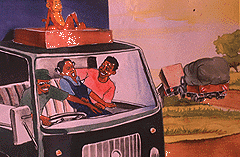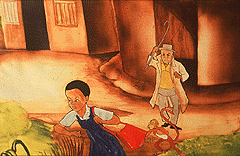by Neill McKee & Christian Clark
In Eastern and Southern Africa a young girl figure is about to be born who has the potential to become as well known as Nelson Mandela. Her name is Sara and she was conceived in ten countries.
 Artwork for UNICEF's new character,
Sara
Artwork for UNICEF's new character,
Sara©UNICEF
Sara is a cartoon character. She is the product of 20 months of research and development work involving over 150 writers, artists, and researchers from Eritrea and Ethiopia in the North, to the Cape of Good Hope in the South. Sara, her friends and family, and the characters and happenings in her community are also the result of discussions with over 5000 people in villages and slums throughout this vast region. It is their insights and reflection which have shaped the adventures of Sara, an adolescent girl between 13 and 15 years of age.
Sara has a similar beginning to Meena, a younger girl cartoon character from South Asia. Both projects have been launched by the United Nations International Children's Emergency Fund (UNICEF) with financial contributions from the Government of Norway and UNICEF committees in United States, Europe and Japan. Meena has been a joint project of UNICEF and Hanna-Barbera Cartoons. Sara is still looking for a corporate partner.
UNICEF recognizes the power mass media can have in providing a catalyst for social change. Meena and Sara are examples of an "enter-education" strategy, which seeks to harness the drawing power of popular entertainment to convey educational messages. These initiatives illustrate how creative and exciting stories can be used to promote social issues in an appealing and provocative way. Meena is quickly becoming a household name and a popular film star in South Asia. In December 1995, she was identified by Newsweek Magazine as "one of the actors to emerge on the world's stage in 1996."
Role Models
Both Meena and Sara are uplifting role models for girls. They are empowered girl figures who are able to act, to ask questions and seek solutions to the problems which face them and their friends and family. And their problems are many. In South Asia and Africa, there are many customs and traditions which affect the development of female Children. In India, a million fetuses are detected and aborted each year simply because they are female. In both regions there is much more value and attention given to the boy from in the first hour of life and this continues through childhood.
From a young age the girl must serve male family members, care for younger children, fetch water and firewood, wash the clothes and cook. Her life becomes a "nightmare that never ends." The girl is often seen as someone who is "just passing through" the household. She will get married and move out whereas it is believed that the boy will support his parents in their old age.
 Meena and her
friend Mithu
Meena and her
friend Mithu©UNICEF
As the girl grows, the disparities in treatment and status are compounded. Death rates are higher among female children. When sickness strikes, male children will be taken to hospital sooner, while girls have to wait to the very last moment, which is sometimes too late.
In many countries, fewer girls enter school and more girls are "pushed out" at an early age. This disadvantage in educational opportunities also robs the girl of her chance to be a child as school is one of the only places where she can socialize and play with other children and learn essential life skills such as communication, negotiation, problem solving and conflict resolution.
Another aspect is the socialization process of the young girl in the home, school and wider community. She acquires a sense of inferiority, resulting in a negative self-concept. It is reinforced by the way girls and women are defined in textbooks and various media. The overall result is a limited perception of her own capabilities and possibilities.
In many parts of Africa the problem of teenage motherhood is endemic. Girls are often not yet ready for motherhood, physically or psychologically, and are thrown out of the educational system. Their situation becomes even more worrying in the context of the AIDS pandemic, which is hitting both regions harder than any other area of the world. In Eastern and Southern Africa, rape, adolescent pregnancies, female genital mutilation, forced marriage, polygamy and multiple partner relationships all have contributed to the rapid spread of HIV/AIDS. The adolescent girl is two to seven times more likely to be HIV positive than the adolescent boy.
Striking a Common Chord
This is a negative and depressing picture. While it is possible to present the female child as a victim requiring assistance and protection, it is more important to recognize her potential as a leading agent in promoting development. In both the Meena and Sara Communication initiatives, UNICEF decided to create a role model and set of common stories which would provide motivation for a way towards acceptable solutions.
But how can cartoons address such deep-rooted problems? In viewing live action films, people in multi-ethnic environments respond to cultural and social cues such as dress, facial features, language and accents, housing and vegetation which may alienate and distract them. They may be fascinated by what they see but may miss the main message or conclude that the situations posed are "someone else's problem." However, with proper formative research, animated film can be used to "strike a common chord" across a diverse region. Common characters, backgrounds and stories can be found which belong to everybody's neighborhood.


Sara and her pet monkey Zingo, shown in a victim situation requiring assistance and protection.
© UNICEF
In creating the series, research revealed the need to remain within the
realm of realism in order to maintain a credible message source. Therefore,
Meena's parrot, Mithu, only ever repeats what he has heard and Sara's pet
monkey, Zingo, does not talk. She only mimics and gestures in sympathy with
Sara's emotions. Both animals are extensions of the girls' egos. They can
do things which the Meena and Sara would like to do but which would be disrespectful,
for a girl to do in Asian or African society. Therefore, cultural sensitivity
is maintained. By steering this fine line between reality and fantasy, the
e stories remain both relevant and exciting to the target audiences. They
are their stories. What the research revealed is that the target audiences
don't have a vocabulary for 'cartoon' versus "live action." The
Meena and Sara films are viewed as stories on their situations and lives,
as opposed to the live action fantasies churned out by Hollywood or BollyWood.
The Flagship Medium
Also, animated film can portray difficult social issues and values in sensitive,
non-threatening ways, without losing message impact. The stories and messages
provide a "hook"" into the culture without alienating or
threatening cultural integrity. In addition, animated films can be dubbed
and produced in many languages at little cost, making them useful across
a large population base.
In both Meena and Sara initiatives, the animated film is the "flagship"
medium through which a set of characters and core set of stories "come
to life," capturing the attention and imagination of audiences and
providing a creative focus, However, multi-media dissemination is essential
to reach target audiences who often do not have access to television, video
or film. A Meena radio series has been broadcast in Asia through the BBC
Bangla service and the BBC Africa Service will broadcast a five language
Sara series beginning in June 1996. In addition, comic books, story books,
audio cassettes, posters, users' and facilitators' guides are either available
or in planning.
However, films and videos have further reach than is often assumed. India
has had satellite television with community viewing stations since the 1970s.
There are also growing informal channels of video distribution - associations,
religious groups and commercial outlets, for example. Videos are shown in
public places such as restaurants and bars and "video theaters"
are quickly growing in small communities. in some countries there are mobile
film or video units owned by private firms or government.
Also in the plans for both Meena and Sara is the merchandising of products.
In Bangladesh Meena textiles, ceramics, dolls, writing products and greeting
cards are already being pilot marketed and educational games are planned.
Such products have the potential to extend the reach of Sara and Meena images
and messages. They also may have a role in fund raising, thereby sustaining
the projects, for it is recognized that changing the societal position and
view of female children is a long-term endeavor.
A First Step
Broadcast or video viewing is important in developing awareness and knowledge
as a first step to behavioral change information is provided and awareness
enhanced. We can also motivate people through entertaining Program formats.
However, in the Meena and Sara episodes, an attempt has been made to address
all behavioral change factors. The episodes are informative and motivational,
through entertaining stories which are based on careful research into traditional
and modern values. But they also address the life skills and enabling environment
factors which are so often omitted change behavior or bring in children.

A storyboard session for the UNICEF South African Initiative.
© UNICEF
Finally, both initiatives have involved a great deal of capacity building.
The design of the Meena character, character models, backgrounds, storyboards
and post production has all been undertaken in South Asia under the supervision
of Ram Mohan of Light Box Moving Pictures, Bombay. Light Box has also produced
some of the episodes from start to finish-h although Hanna Barbera Manila-based
studio, Fil Cartoons has produced the bulk of the animation to date. South
Asian artists and researchers have increased their skills through their
involvement.
Ram Mohan and the others of the South Asian team -- Mira Aghi, the chief
researcher in New Delhi; Rachel Carnegie, Meena's main creative force and
former coordinator; Nuzhat Shahzadi, researcher and trainer-disseminator
based in Bangladesh -- have all contributed to the training of African artists,
writers and researchers in the Sara project. And such capacity building
remains a major goal of both projects.
The Meena and Sara initiatives are two visible bright stars in the African
and South Asian girls' otherwise troubled night sky. They demonstrate how
animated film can become a force for social transformation.

A depiction of the South African picturesque landscape.
© UNICEF
Neil McKee is the Senior Program Communication Officer for UNICEF's
Eastern and Southern Africa Regional Office based in Nairobi, Kenya. He
is the author of Social Mobilization and Social Marketing in Developing
Communities.
Christian Clark, former Information Officer in UNICEF Somalia, is now
the Meena Project Coordinator for UNICEF in Katmandu, Nepal.